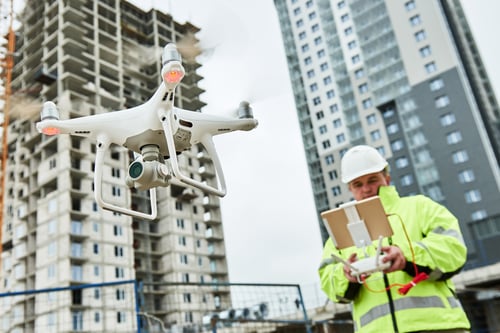2024 Technology Trends in the Construction Industry

The construction industry has been characterized by being very traditional and resistant to change, but many emerging technologies have promising applications in building projects. Two of the main challenges for developers, designers, and contractors are reducing costs and increasing safety, and there are technological innovations that can help with both aspects.
This article provides a brief overview of some emerging technologies that could transform the construction process. A common denominator among many of them is access to a wealth of information that was not been possible before. Design your next building project with the latest engineering tools.
Drone-Based Supervision and Inspection

Drones are no longer hobbyist gadgets; they now have applications in many business sectors. When deployed in construction monitoring and building inspection, they bring the following advantages:
- Drones can be programmed to sweep a large project in a matter of hours. They can gather data volumes that would require many days or weeks to be collected on foot.
- Drones can observe constructions from viewpoints that are inaccessible to humans. This way, they can detect issues that are normally hidden from sight.
- Drones improve safety, taking observations that would expose surveyors to injury.
By making supervision faster, drones can achieve significant cost savings. When aided by drones, an engineering company can supervise a larger number of projects simultaneously. Working conditions are also improved since surveyors can inspect hard-to-reach places without exposing themselves.
Augmented Reality
With augmented reality (AR), a special lens can overlay key information during project site visits or when inspecting existing buildings. This is very useful during all stages of the building life cycle: design, construction, maintenance, and renovations.
AR systems can display key information about equipment as the user looks at components, or they can display warnings when there are risks nearby. For example, AR lenses can signal surfaces that are at high temperatures or electrically charged.
AR can also be used to discuss projects with clients. For example, a completed project can be overlaid on an empty site or inside an existing building, so that the client can clearly visualize the final result.
Connected Devices
Using sensors to monitor a building and manage it more effectively is nothing new. However, the Internet of Things (IoT) is bringing connectivity to all types of devices; in the case of construction, this includes equipment, tools, and even the gear worn by construction personnel. This generates abundant data that can be used for many purposes:
- Live monitoring which allows construction activities to be programmed more efficiently while preventing accidents.
- Tracking the performance of specific tools and equipment, revealing potential ways to improve their efficiency.
Connected devices can greatly benefit from GPS tracking, especially construction equipment that travels long distances between projects. For example, when heavy machinery is equipped with telematics, construction managers can know the exact location of each truck and the distance traveled per day. This enhances fleet management while helping prevent theft.
Cloud Services and Data Storage

Emerging technologies are characterized by generating large amounts of data, which must be processed and stored. Although construction companies can deploy their own data centers, this requires large amounts of capital and ongoing support from an IT staff. Cloud solutions grant access to IT infrastructure and technical knowledge as a service, where users can pay a subscription fee instead of spending on their own data centers.
In addition to storing large amounts of data, cloud solutions make it accessible for project managers while keeping it secure in a remote location. This information can also be accessed by connected devices or by data analysis platforms.
Artificial Intelligence and Data Analysis
The data volume produced by multiple connected devices is often too large for human analysts, requiring artificial intelligence (AI) to be processed effectively. AI platforms can access data stored in the cloud and process it into simple and intuitive metrics that are useful for decisions.
Engineering teams looking to harness the value of their project data often adopt programming tools that streamline data collection and analysis. For those interested in upskilling, a variety of Python courses and tracks are available online, equipping professionals with essential skills for automating workflows, visualizing site progress, and making informed decisions from construction datasets.
The construction industry is characterized by its high exposure to risk and uncertainty, but this can start to change with AI services. By shifting from a reactive to a proactive approach in project risk management, construction companies can reduce costs while improving safety. Data analysis also has applications in procurement, where it can be used to program material purchases based on price trends, achieving better deals and ensuring timely delivery.
Prefabrication and Modular Buildings
The off-site assembly of building components brings many benefits, compared with the traditional approach of building a structure from zero at the project site:
- Part of the construction process is performed in a controlled factory environment, which minimizes waste.
- Prefabrication is carried out in an environment that is protected from the weather, one of the main factors that brings uncertainty to the construction process.
- Since there are fewer external factors that influence the project during prefabrication, a higher quality can be achieved.
Prefabrication can be a powerful tool in competitive markets like New York City, where there is a significant financial reward from completing a real estate project early. Both residential and commercial development have been growing fast, and the quick construction process of a modular building means that the developer can start collecting rent payments earlier.

Michael Tobias
Michael Tobias, the Founding Principal of NY Engineers, currently leads a team of 150+ MEP/FP engineers and has led over 4,000 projects in the US
Join 15,000+ Fellow Architects and Contractors
Get expert engineering tips straight to your inbox. Subscribe to the NY Engineers Blog below.
